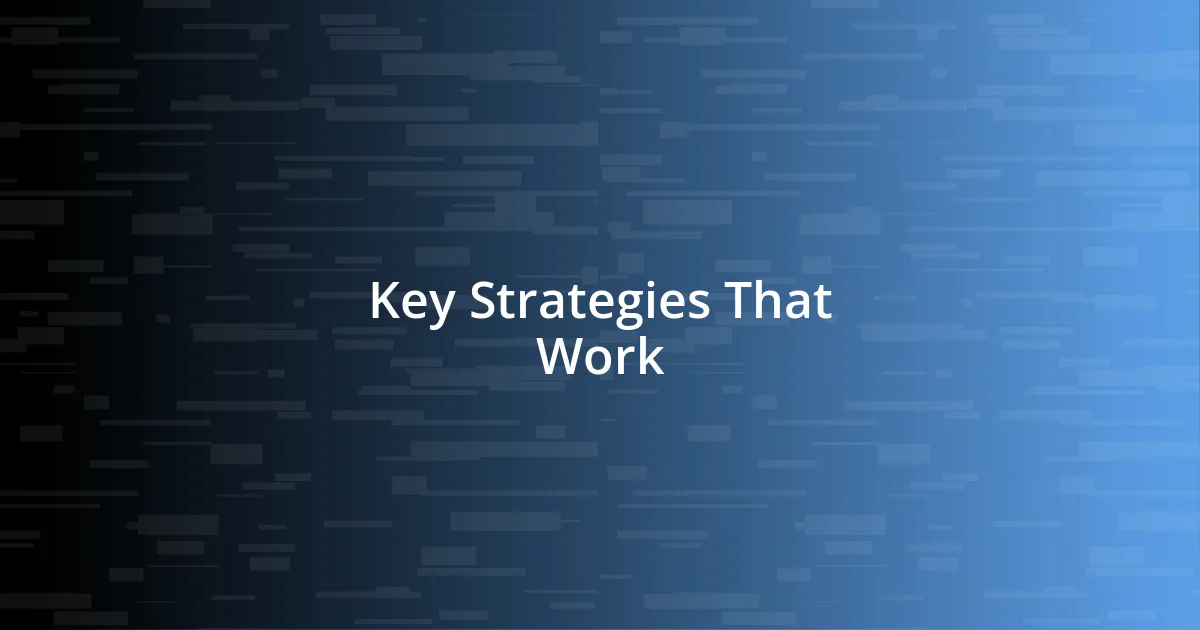Key takeaways:
- Emotional discipline and a solid trading plan were pivotal in overcoming early trading mistakes and impulsive decisions.
- Implementing strict risk management strategies, like setting stop-loss orders and position sizing, safeguarded capital against market volatility.
- Continuous learning through reflection and networking with other traders enhanced trading skills and decision-making processes.

My Day Trading Journey
My day trading journey began in my living room, where I would spend countless hours glued to my computer screen. I distinctly remember my first trade—my heart raced as I clicked “buy” for a stock that I had researched all night. It was exhilarating, but I quickly learned that the adrenaline rush comes with its own risks.
In the early days, I made my fair share of mistakes, like over-trading out of sheer excitement. I vividly recall losing a significant amount on a hasty decision driven by emotions rather than strategy. Have you ever found yourself caught in that whirlwind of impulsive choices? Understanding my emotional triggers became essential, and I had to adopt a more disciplined approach to trading.
As I progressed, I discovered the importance of developing a solid trading plan. I began to appreciate the power of routine, setting specific times during the day to analyze my trades and adjust my strategy. What has worked for me might not work for everyone, but finding that rhythm was transformative—a steady heartbeat in the often-turbulent world of day trading.

Key Strategies That Work
When it comes to day trading, one strategy that consistently works for me is sticking to a clear set of entry and exit rules. I can’t stress enough how having my rules written down has saved me from the emotional rollercoaster of trading. There’ve been days when I was tempted to go off-course because of market hype, but recalling my guidelines helped me stay grounded. Have you ever felt the urge to deviate from your plan? I certainly have, and following my predetermined rules has often kept me from making costly mistakes.
Another key strategy I find crucial is practicing risk management. I set a strict limit on how much I’m willing to lose on any single trade, and this approach has shielded my capital from significant downturns. I remember one particular trade where I ignored my own advice and took a larger risk. The loss was painfully evident, and since that day, I’ve prioritized knowing when to walk away—even if it meant closing a position that I was emotionally invested in.
Lastly, leveraging technology has revolutionized my trading approach. I’ve invested in multiple trading platforms that provide real-time data and analytics. These tools have enhanced my decision-making process significantly. For instance, utilizing charting software to identify trends has given me clarity that my instincts sometimes miss. It’s fascinating how these technological advancements can simplify complex data into actionable insights, wouldn’t you agree?
| Strategy | Description |
|---|---|
| Entry and Exit Rules | Set clear guidelines to manage trades and minimize emotional decisions. |
| Risk Management | Define maximum losses per trade to protect your capital. |
| Leveraging Technology | Use advanced trading platforms and tools for real-time data analysis. |

Time Management for Day Trading
Time management is critical in day trading, as the markets can shift in an instant. I’ve learned to carve out specific times each day for different trading tasks, which helps me stay organized and focused. Believe me, nothing feels worse than missing an opportunity because I got caught up in a rabbit hole of distractions. I remember one particular afternoon when an unexpected market movement caught me off-guard because I had strayed from my schedule—what a lesson that was!
Here’s how I manage my time effectively for day trading:
- Set a Daily Routine: Allocate fixed time slots for pre-market analysis, trade execution, and end-of-day reviews.
- Limit Screen Time: Designate specific hours for trading to prevent burnout and distraction from other tasks.
- Use a Timer: Employ a timer for focused trading sessions to enhance concentration and maintain efficiency.
- Review and Adjust: Dedicate time at the end of each day to review trades and adjust strategies for the next trading session.
Balancing my time has let me engage with the market without feeling overwhelmed. I prioritize my analysis time and ensure I’m ready before the market opens. It’s all about rhythm; finding what suits you reduces the chaos and allows you to make confident decisions without hesitation.

Tools for Effective Trading
Having the right tools is essential for effective trading. I rely heavily on a fast and reliable trading platform, as slippage can truly derail a trading plan. There’s nothing more frustrating than missing an optimal entry because my software lagged—has that ever happened to you? I remember one time when a delay cost me a significant opportunity, and since then, I prioritize investing in technology that keeps up with market demands.
Charting tools also play a pivotal role in my daily trading routine. I often spend extra time analyzing candlestick patterns and volume indicators for deeper insights. Recently, while experimenting with customized indicators on my charts, I identified a trend that led to a profitable trade. It made me realize how important it is to choose tools that resonate with my trading style and to continually adapt them as needed. Can you think of a moment when your analytical tools really made a difference?
Lastly, I use news aggregators to stay ahead of market-moving information. Staying informed about economic indicators and company news shapes my trading decisions. There’s a certain exhilaration I feel when breaking news aligns perfectly with my chart analysis—those are the trades that showcase the power of being prepared. The right tools not only enhance my trading effectiveness but also provide me with confidence in my decisions, don’t you think? Every little detail counts when you’re playing the day trading game.

Risk Management Techniques
Managing risk is one of the most critical aspects of day trading. I always set a strict stop-loss order for each trade to limit my potential losses. It’s like having a safety net—I remember a day when a sudden market swing saw my position tanking. Thanks to my pre-set stop-loss, I walked away with minimal damage rather than losing much more. What a relief it was!
Another technique I’ve adopted is position sizing, which helps me minimize my exposure to any single trade. I calculate the amount I’m willing to risk based on my account size and stick to that. There’s something reassuring about knowing that no matter how wild the market gets, I’m only risking a small fraction of my capital. Have you ever felt the weight of over-leveraging? Trust me; being conservative with your position can save you from sleepless nights.
Diversification has also played a significant role in my risk management strategy. Instead of putting all my eggs in one basket, I spread my trades across different sectors or instruments. I recall a day when a specific stock I was heavily invested in plummeted unexpectedly. However, because I had diversified my trades, my overall losses were contained. It taught me that mitigating risk isn’t just about individual trades—it’s about the bigger picture, too. Isn’t it freeing to know that a well-rounded approach can safeguard against unforeseen market shifts?

Analyzing Market Trends
When analyzing market trends, I find that identifying key price action levels can reveal a lot. For example, the last time I recognized a significant support level on a stock I was interested in, it felt like a light bulb went off in my mind. That moment propelled me to set up trades right around those levels, and I walked away with a nice profit—has there been a time when recognizing a trend changed your trading game?
Utilizing moving averages is another method I often lean on. By tracking short-term and long-term moving averages, I can gauge the overall direction of the market. A few months ago, I noticed a crossover on my charts that signaled a potential entry point. I entered the trade with confidence, and it paid off—it’s those little indicators that can fuel our understanding of market momentum, don’t you agree?
Lastly, I make it a habit to consider market sentiment alongside the technical analysis. I remember a day when headlines suggested bearish sentiment, yet my analysis showed bullish signals. Ignoring the noise, I trusted my instincts and was rewarded when the market rallied. It reinforced my belief that while statistical tools are vital, understanding the human element—the emotion driving the market—can really tip the scales in our favor.

Lessons Learned and Advice
Sure! Here are some reflections on lessons learned and advice based on my experiences in day trading:
Every trader should embrace the reality of making mistakes. I’ve had my fair share, and while they sting at the moment, they’re invaluable learning moments. After losing a significant amount on a trade due to my overconfidence, I learned to always review my decisions, almost like a personal debrief after a game. Isn’t it interesting how reflection can sharpen our skills even more?
One piece of advice I often revisit is to stick to your trading plan. Early in my journey, I allowed emotions to steer my trades. The resulting chaos was maddening. Now, I find comfort in the discipline of following my objectives. Do you ever find yourself second-guessing your own strategies? Trusting your process can feel liberating, and it fosters a sense of control amidst the market’s unpredictability.
Additionally, networking with other traders has enriched my understanding immensely. I remember joining a trading group online, and the fresh perspectives I gained were refreshing. Sharing insights and hearing about others’ strategies introduced me to concepts I hadn’t considered before. Do you engage with a trading community? It’s amazing how collaboration can elevate our skills and decision-making processes.














